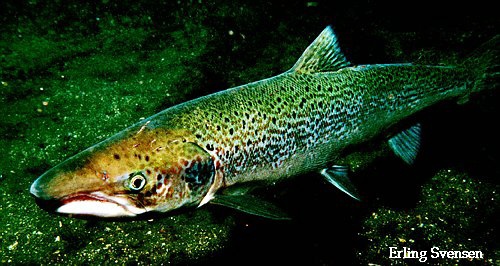Identification:
When caught at sea, or fresh-run (having recently entered freshwater),
the salmon has a bright silvery colour, with small dark spots, mostly above
the lateral line. The salmon is generally more slender and streamlined than
the sea trout, with a slightly narrower tail. In common with other salmonids,
there is a fleshy adipose fin present between the dorsal and tail fins. The
tail fin is slightly more curved than in the sea trout.
Breeding:
Salmon return from the sea to breed from spring onwards, detecting
their river of birth by a remarkably developed sense of smell. On entering
freshwater, salmon cease to feed. Their stores of body fat built up at sea
are used in migrating to the upper reaches of rivers, often requiring navigating
such obstacles as weirs and waterfalls. As the journey upstream continues,
the sexual organs ripen, the skin colour gets darker, and the male develops
a hooked lower jaw. Spawning occurs in gravel beds, where eggs are deposited
and fertilised in depressions (or redds) in the gravel cut out by the female's
tail. After spawning, the spent fish, known as kelts, generally die. A small
proportion survive to return to their feeding grounds at sea, regain condition
and can breed again. The eggs hatch releasing young (15-20mm) known as alevins,
still nourished by the remnants of the yolk sac, and they remain in the safety
of stones on the river bed. On increasing in size, they emerge to feed on
insect larvae and other small animals, and by the time they are around 5cm
long, are known as parr. At this stage, the salmon has a row of darkish
"fingerprints" along the lateral line, and numerous black and red spots.
At 2-5 years old, the salmon enters the smolt phase, and begins its migration
to the sea, becoming a more uniform silvery colour. Time spent at sea can
vary from about 1-5 years. Smaller fish (up to 2.5kg), returning after just
one year at sea are known as grilse. After 3 years at sea, salmon may weight
8-13kg.
Habitat:
*covered in other parts of this piece
Food:
While at sea, salmon feed on small fishes, such as sandeels and sprats, and
also crustaceans.
Range:
Migrating salmon can be found at sea throughout the British Isles,
but most commonly in the estuaries of less polluted northerly rivers. The
major feeding grounds for the Atlantic salmon are located off the southwest
of Greenland.
Additional Notes:
Salmon are a very popular and valuable commercial species, both in fresh
and smoked form. The majority of salmon sold in the fishmongers will have
been reared on fish farms, to which the sheltered Scottish sea lochs are
well suited. |
